“The Infinite Vulcan”
Written by Walter Koenig
Directed by Hal Sutherland
Animated Season 1, Episode 7
Production episode 22002
Original air date: October 20, 1973
Stardate: 5554.4
Captain’s log. The Enterprise is surveying a planet at the periphery of the galaxy. A landing party consisting of Kirk, Spock, McCoy, and Sulu beams down. Sulu finds a plant that can get up and move around, while Spock finds a power source. Kirk, Spock, and McCoy investigate the power source, while Sulu fails his saving roll versus dumbass and picks up the flower. He’s stabbed with a thorn and is poisoned.
A group of natives arrive, who appear to be sentient plant life. They cure Sulu (over McCoy’s initial objections, though he’s impressed with the speed with which the antidote works on Sulu). The leader of the natives, Agmar, identifies the planet as Phylos.
Agmar shows the landing party where the previous generation of Phylosians are interred. They died when a human visited them. McCoy realizes that staphylococcus strains aren’t native to this planet, so the Phylosians were all killed by staph infections. Agmar says, however, that the same human was able to cure them.
Winged creatures called Swoopers suddenly attack the landing party. The building they’re in has a dampening field that deactivates their phasers, and the Swoopers fly off with Spock. Agmar reveals that “the master” has waited a long time for a specimen like Spock.

And then a giant human wanders in. The Phylosians genuflect to the man, who identifies himself as Dr. Stavos Keniclius 5. Keniclius 5 orders Kirk to return to his ship, which Kirk only does under threat of being attacked by the Swoopers again. However, he does not leave orbit, as he will not depart without his first officer.
Sulu is able to adjust the sensors to pick up the sentient plant life on the planet, but he’s unable to detect Agmar and his fellows, or Keniclius 5 or Spock—indicating that they’re in a shielded location. Kirk orders Sulu to fire on the building they were in, but the phasers dissipate a thousand feet over the building.
Uhura is able to track down info on Keniclius: he was a scientist during the Eugenics Wars, working on cloning. He was cast out of the scientific community and disappeared without a trace. Given that Keniclius identified himself as the fifth one, and given how long it’s been since the Eugenics Wars, Kirk figures he’s been cloning himself to prolong his life.

Kirk has McCoy synthesize his great-grandfather’s weed-whacking spray, while Scotty whips up a delivery system. Then Kirk, McCoy, and Sulu beam down, and Scotty under Kirk’s orders leaves orbit, hoping that Keniclius 5 will think they’ve given up and left.
The landing party ducks the Swoopers and find an armada of rocket ships, but they’re covered in moss and other plants. Agmar and his people are clearing them off, possibly so they can be used—but for what? Migration? Invasion?
Kirk kidnaps Agmar, who explains that there are only a handful of Phylosians left now. It will be left to Keniclius and Spock to carry on their work. Agmar takes them down to their tunnel system—made up of a material sufficiently dense that sensors couldn’t penetrate it from the surface—and then abandons them in the darkness to the Swoopers.
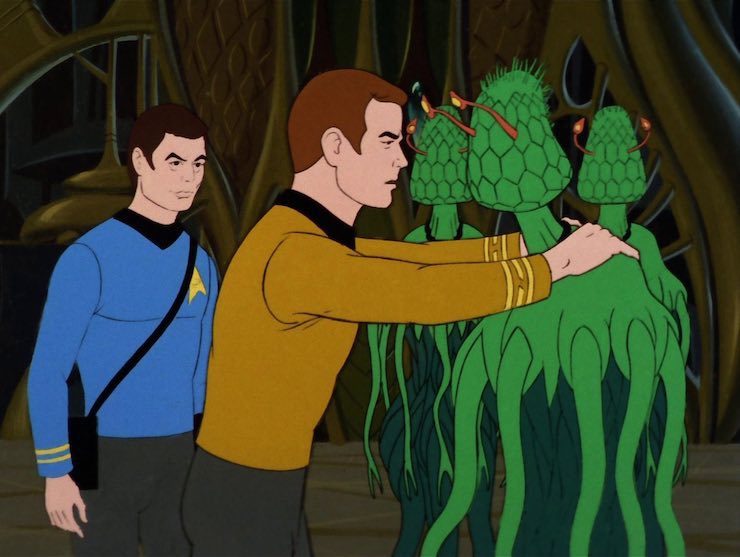
They run to a light at the end of the tunnel (that trick never works!) to find Spock in some kind of clear case, and according to McCoy, he’s dying. But Keniclius 5 has cloned Spock in giant form, and is draining his original body’s mind. (Gee, if only they had experience with something like that…………)
The Swoopers attack, and the landing party whips out Great Granddaddy McCoy’s weed spray, which also drives Keniclius 5 and Spock 2 from the room. But they can’t beam back thanks to the thick walls.
Keniclius 5 returns to reveal that Spock’s mind isn’t being drained, it’s being transferred to Spock 2’s gigunda body. Kirk tries to convince Spock 2 that there’s no logic in allowing Spock to die so his clone can live on. Then Uhura manages to punch through a tight-beam communication long enough to reveal further research: Keniclius wanted to create a master race to pacify the galaxy, and he’s been searching for the perfect specimen.
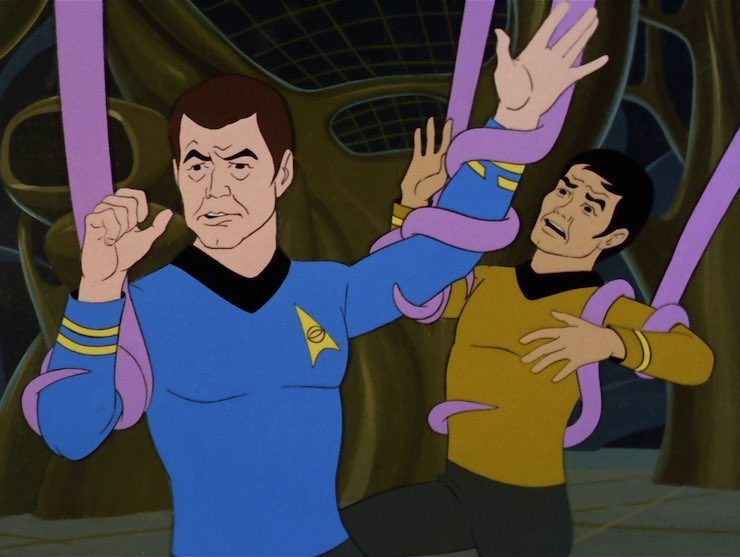
He considers Spock to be it: he wants to create an army of Spocks to bring peace to the galaxy. But Kirk points out that there is peace in the galaxy—the Federation has achieved peace, not by imposing it, but by agreeing to it like civilized folk. Kirk also reminds Spock 2 of the IDIC philosophy. Keniclius 5 counters with the aggression of the Klingons, Romulans, and Kzinti, and mention the Eugenics Wars as well.
Agmar reveals that the Phylosians had intended to use their armada to impose peace in a similar manner, but Keinclius showed up and nearly killed them all before they could enact it.
Spock 2, however, gets his brain meats back together, and mind-melds with his original body (by putting one giant finger on Spock’s forehead), thus restoring Spock’s mind.
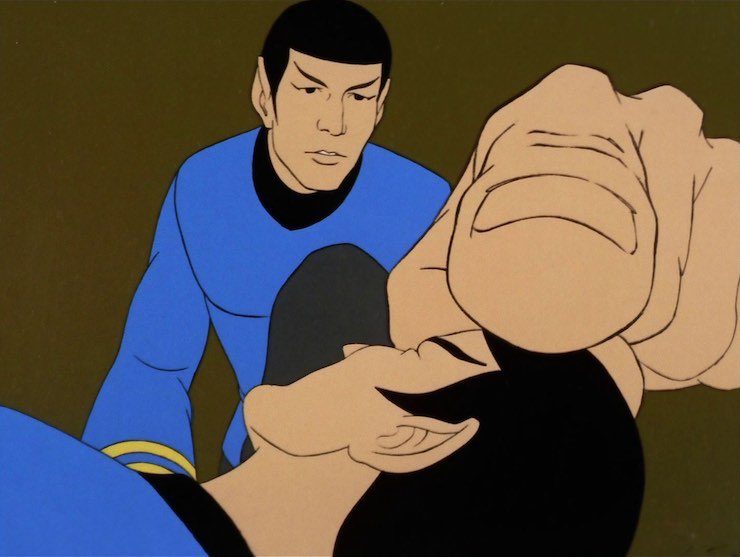
Keniclius 5 agrees to put his plans for a master race on hold. He and Spock 2 will stay on Phylos and work to restore the Phylosian species.
Can’t we just reverse the polarity? On Scotty’s order, Uhura is able to plow a tight-beam communication through the thick walls of the Phylosian tunnels, even though it risks draining the dilithium crystals.
Fascinating. So now there are two Spocks roaming around the galaxy, and one of them is about twenty feet tall. Okay, then.
I’m a doctor not an escalator. McCoy is very cranky about Agmar trying to cure Sulu right up until the point where he actually cures Sulu. He also comes up with a way of dealing with the Swoopers via chemical warfare.
Ahead warp one, aye. It’s a strong episode for Sulu, who gets poisoned and cured, and then gets to fire phasers and do sensor scans, the latter in Spock’s absence, and then does a nifty body throw (probably an aikido or judo throw—hard to tell from Filmation’s clunky animation) when Agmar attacks him. At the end, Kirk asks him to teach the throw to the captain, and Sulu says that he may not be able to, as you not only have to be physical, but also inscrutable. Kirk points out that Sulu’s the most scrutable man he knows, and Sulu winks at the camera. Corny, but funny…
It’s a Russian invention. While Filmation couldn’t afford to hire Walter Koenig to reprise the voice of Chekov (they could barely afford Nichelle Nichols and George Takei), as a make-good, they hired him to write an episode. In fact, he’d been approached to do so independently of his exclusion from the cast due to Susan Sackett, Gene Roddenberry’s personal assistant, typing up a screenplay of Koenig’s and her showing it to Roddenberry, who was impressed enough to offer him a gig writing for the animated series. However, he had to do multiple rewrites, which soured him on the whole experience, and when he was asked to write another, he declined the offer.
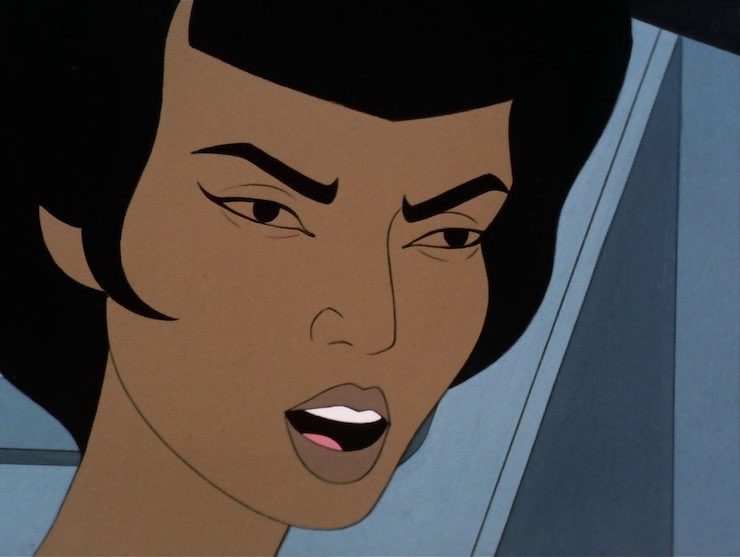
Hailing frequencies open. Uhura finds the Wikipedia entry on Keniclius, but it takes her a while to click on “External links” to find his obscure writings.
I cannot change the laws of physics! Scotty is surprisingly willing to sacrifice engine power to contact the landing party.
Channel open. “I am pleasantly surprised by your capacity for deductive reasoning, Captain. When you are not being bellicose, there appears to be no end to your arsenal of formidable talents.”
Spock sort of paying Kirk a compliment.
Welcome aboard. Busy week for James Doohan, who provides the voices of Scotty, Agmar, and Keniclius 5. Nichelle Nichols is both Uhura and the voice of the computer, while George Takei just does Sulu. Walter Koenig lobbied to be the voice of Keniclius 5, but was not given the part.
Trivial matters: Keniclius was a scientist working during the Eugenics Wars, which were first referenced in “Space Seed,” and trying to create a master race. It’s not clear whether or not he was an Augment like Khan or simply a scientist working at the time that Khan reigned.
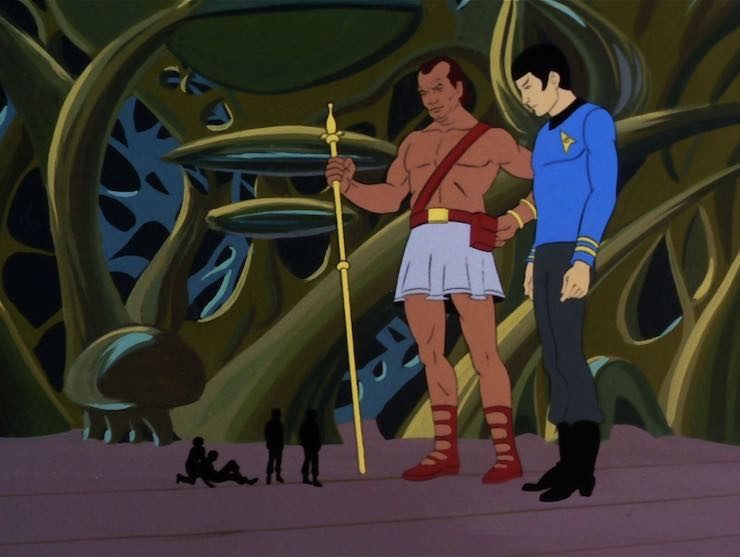
Keniclius mentions the Kzinti, as well as the Klingons and Romulans. A creation of Larry Niven for his science fiction novels, the Kzinti will be seen in the Niven-penned episode “The Slaver Weapon.”
Kirk reminds Spock of the Vulcan philosophy of Infinite Diversity in Infinite Combinations, first mentioned in “Is There In Truth No Beauty?”
We’ll see a Phylosian again, on the council in “The Time Trap.”
The plant that poisons Sulu is called a retlaw, which is the scriptwriter’s first name spelled backwards.
Keniclius was modeled after Koenig.
To boldly go. “The master always speaks the truth.” This is a very ambitious episode, with a lot of really nifty ideas, and some rather heavy plot elements. It’s pretty impressive for a 1970s Saturday morning cartoon to show us a room full of corpses, though the censors probably didn’t blink because they were plants. The notion of sentient ambulatory plants is a fun one, though not as much is done with it as one might hope, and the design is nicely alien, continuing the work the animated series has done from jump in giving us truly alien designs. And given that Spock has been regularly shown to be a kind of superman, the idea that Keniclius views him as a perfect base for a clone army of telepathic soldiers with the strength of a Vulcan and the passion of a human is actually a really clever extrapolation of how Spock has been portrayed. I like that the script acknowledges something that Star Trek in general has ignored repeatedly, which is the very real possibility of bacterial contamination of the strange new worlds they visit. And it’s good to see so much contributed to the story by Uhura and especially Sulu. (The ending cracks me up every time, though I could live without the oh-so-70s wink at the camera.)
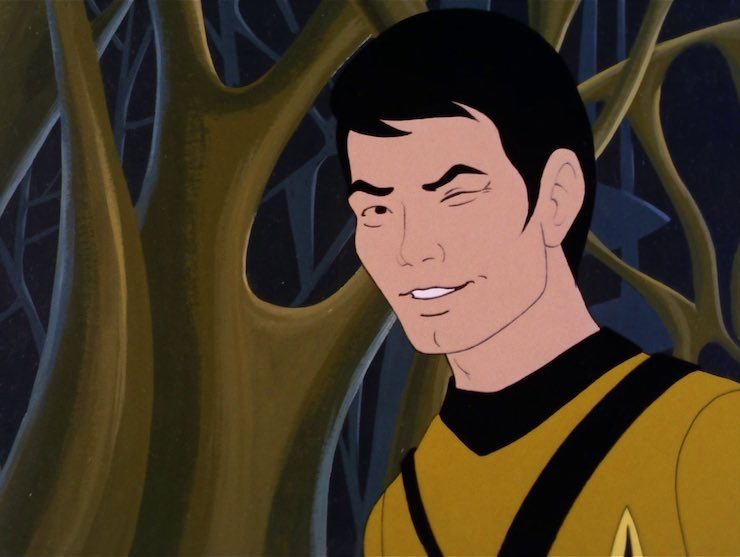
On the other hand, a lot of the episode is a mess. People just sort of wander into and out of rooms as the plot needs them to be there. Kirk, Spock, and McCoy all check the building, and leave Sulu behind for no obvious reason except that the plot calls for him to be poisoned while he’s by himself. Keniclius and Spock leave the room when the landing party sprays the Swoopers, and then just walk back in. Agmar leaves the landing party alone in the dark with the Swoopers and then do nothing to stop them just running to the lab that they wanted to go to in the first place. Nobody can agree on how to pronounce “Keniclius.”
And for what possible reason does Keniclius make his clones twenty feet tall? And for what possible reason does Kirk think it would be a good idea to just leave Keniclius 5 and Spock 2 alone with a bunch of would-be conquerors to just hang out on Phylos and do science?
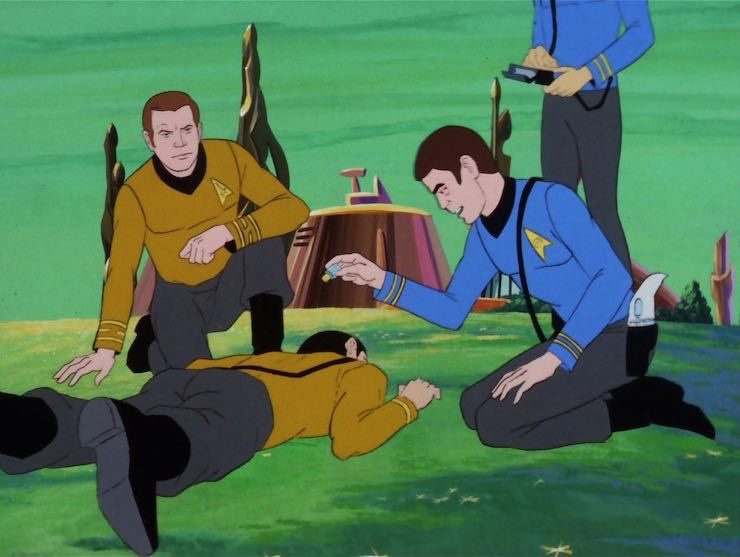
William Shatner still hadn’t gotten the hang of acting only with his voice in this one, as a lot of his line readings are disastrous, particularly his speeches to Spock 2 and his being bellicose at Keniclius 5.
It’s funny, my instinct is to say that this was a promising first draft that just needed tweaking, but apparently Koenig did something like a dozen rewrites.
Still, there’s interesting stuff here. Too much ridiculous to be good, but too much good stuff to be bad. So we give it a…
Warp factor rating: 5
Next week: “The Magicks of Megas-Tu”
Keith R.A. DeCandido will be making his first public appearance of 2017 this weekend at Arisia 2017 in Boston, Massachusetts, alongside Guests of Honor Ursula Vernon, Stephanie Law, Greykell Dutton, and Susan Fox & Gene Turnbow from Krypton Radio, and tons of other neat folks. Keith’s schedule can be found here.











Yep, the plot is a mess. In addition to the problems you mentioned, I also wonder why the fifth clone of a twentieth-century guy would walk around in an ancient Greek male miniskirt. Because his first name ends with -os? Why are there stories about “a modern Diogenes wandering the galaxy looking for someone special”? The historical Diogenes didn’t do anything like that. Why do they need McCoy’s grandfather for a recipe for weed spray? How can a mind meld restore a drained mind, or duplicate a mind, or whatever? It’s all so silly.
The Kirk-Sulu dialogue in the final scene was great, but not enough to save the episode.
If Keniclius (1) was active during the Eugenics Wars, he might have grown up (or been a teen) in the 80s.
It’s not too much of a jump to go from “army of interstellar supersoldiers” to “Zentraedi.” Maybe Uhura should’ve sung at him.
What am I missing about why the final dialogue is so great? “Inscrutable Oriental” is one of the oldest anti-Asian stereotypes. Why is it hanging around in the 23rd century? Why are Kirk and Sulu finding this so funny? What am I missing?
I’ve always found this a rather silly episode, but it never struck me before how much it feels like a Gold Key comic book, with all the random weirdness tossed in. It’s a planet of talking plant people! And they have a super-technology beyond anything in the galaxy! And they planned to launch an armada to conquer the galaxy for peace! And they have a human scientist as their master, but he’s 20 feet tall for no reason! And now Spock has a 20-foot-tall clone!
(Although, to be fair, the previous generation of Phylosians were also giants, with Agmar’s human-sized bunch being a stunted remnant. The implication is that Keniclius used Phylosian technology to clone himself and Spock, and therefore came out on the scale of the Phylosians at their peak.)
And why did Keniclius think that a clone of Spock would be any more cooperative with his plans than the original one? If he could convince or brainwash the clone of Spock, why not do the same with the original? Kirk even states in dialogue how pointless the whole thing is. (Again, unless the giant clones are necessary to operate ships built on the scale of the original Phylosians.)
It also doesn’t make sense that Scotty was willing to risk draining the ship’s power so completely just to get some historical background of dubious utility to the landing party. Why not just beam down a security team with a signal amplifier or something?
Keith, I’m surprised you’re amused by the “inscrutable” thing at the end. That’s a hoary, xenophobic stereotype of Asians, that they’re this mysterious Other race that’s too weird and alien for normal (white) people to comprehend. It’s also stereotyping Sulu to paint him as a martial-arts expert just because he’s the resident Oriental, something that the live-action series never did (although it was something Filmation did repeatedly — see also Brian Tochi in Space Academy and Evan Kim in the 2-part finale of The Secrets of Isis). For me, it’s an offensive and unpleasant coda to a mess of an episode.
On top of everything else, even the music editing is clumsy in this episode. Mysterious or contemplative cues continue well into scenes where they should’ve given way to suspense or action cues. Fragments of cues repeat and jump around distractingly. It’s remarkably awkward. Oh, and on the bridge scene in the middle of the episode, Spock is visible at his station even though he’s supposed to be a captive down on the planet.
I read the ending bit as making fun of that stereotype — Sulu’s line was a joke, and Kirk was pointing out how ridiculous the notion of Sulu as inscrutable actually is, as he isn’t that at all.
Maybe I read too much into it, but that’s why I thought it was funny, as a repudiation of the stereotype. *shrug*
—Keith R.A. DeCandido
@5/krad: That’s how I read the ending too.
It even makes sense in-universe. I imagine that Sulu, with his love of old stuff (weapons collection, fencing, Dumas), learned about the “inscrutable” stereotype from an old novel or film and thought it was funny.
@5/krad: I’m sure that was the intent; there was a similar exchange deleted from “The Corbomite Maneuver” about how Sulu was nothing like the “inscrutable Oriental” stereotype, apparently included in the scraps of footage in the new Roddenberry Vault DVD and in the Blish novelization of the episode. But both of them (especially the “Corbomite” one) read to me as implicitly calling the stereotype legitimate and portraying Sulu as an exception.
Which plays into the way non-Western characters were often portrayed in ’60s TV, with the good ones being the Western-educated ones who were perfectly assimilated in their behavior and the bad ones being the ones who still embraced their native cultures. Asian or Asian-coded characters in TOS other than Sulu tended to come off very badly (cf. Genghis Khan in “The Savage Curtain” and the Kohms in “The Omega Glory”), but Sulu was “the good one” because he was thoroughly Westernized.
It’s always good to see a non-human and a non-humanoid race so this episode get bonus points. Also, with Spock out of action, we get to see the rest of the crew (or, at least the regulars) step into the void. More bonus points. Yeah, there’s parts that don’t make sense but the giant clone stopped being an issue for me around December, 1991 with the release of The Undiscovered Country. I think this answers at least part of the question of “What happened next”
Looks like it could be Spock or Keniclius. Either way, it makes sense for them to attend a galactic peace conference.
One thing that didn’t make sense and wasn’t stated clearly was, just how did Keniclius expect to create an “army of Spocks” when, by his own admission, he could not duplicate what was learned so (as far as he knew) only one sentient Spock could exist at a time. Was he planning to deploy an “army” of one Spock? It seems strange to call that an army.
On an unrelated point, I found it interesting that Keniclius brought up the Kzinti. Those weren’t seen in the Trek universe until later (The Slaver Weapon by Larry Niven) although they were already created by Niven for his own series of books. It seems that Walter Koenig must have known about that when he wrote this story.
@9/richf: Well, Keith said the script went through multiple rewrites. The Kzinti reference may have been added in one of the later rewrites after “The Slaver Weapon” had been commissioned.
Although I don’t think there’s any way to reconcile “Slaver” with modern Trek continuity or chronology (we’ll get to that at the appropriate time), so I tend to think that Keniclius was just mispronouncing “Xindi.”
@7/Christopher: Perhaps I’m being dense (again), but I don’t see anything in the dialogue “implicitly calling the stereotype legitimate”.
@8/kkozoriz: I keep staring at the picture you included, but I see neither Spock nor Keniclius, nor any giant. What am I missing?
By the way, giants are impossible anyway. Not that this is really a criticism of the episode, in a show that has shapeshifters, energy beings and humanoid aliens.
@9/richf: Since the computer says that Keniclius wanted to build a “master race” from a “prototype”, perhaps he planned to clone Spock in a more traditional manner afterwards, when he had more time. After all, duplicating someone as an adult and then transferring their mind is a rather unusual kind of “cloning”.
Transferring a mind was such a big issue in “Return to Tomorrow” and “Turnabout Intruder”, and here everyone just accepts it and goes on. Oh well, I guess they have gotten used to it by now.
Is “Stavos” another almost-existing name like “Chekov”? Because there is a Greek name “Stavros”.
Sulu was adept in one martial arts discipline; sword!
He carried a lamp about in the daytime, saying that he was looking for an honest man — though it seems fair to say the reference is mangled.
11. JanaJansen – between the two flags. It’s more obvious when he’s moving. There’s a number of tall aliens in the back. The one with the yellow sash is my choice to be Spock or Keniclius
And giants aren’t impossible. We saw two of them in this episode.
Giant Spock was underwhelming (and rather pointless). The way the scenes are staged, you really don’t get a good sense of scale. I blame the limited animation.
Otherwise, it’s a surprisingly brisk and packed episode, with a lot going on. I only wish half of it wasn’t a mess of plot conveniences, designed to place the characters in needless jeopardy. There are some good ideas to be found there, the concept of talking plants being one of them. And it made good use of the supporting characters.
My only concern is in regards to the idea of cloning yourself in order to extend your life. Maybe I’m getting this wrong, but to me it doesn’t make a lot of sense. What guarantees your clone is going to be the same person you are? Even if you transfer your memories, there ought to be enough variables to open up new paths in life. If the idea is for your clone to continue your work, I don’t see this being effective at all. And if you just want to live forever, cheating death, it’s really more of a half-measure. You’re still going to die, with no way of knowing if your clone is going to be all right afterwards. I think it would have been more effective if Keniclius had transfered his memories into a computer.
@11/Jana: “Perhaps I’m being dense (again), but I don’t see anything in the dialogue “implicitly calling the stereotype legitimate”.”
Saying “you have to be inscrutable” to do martial arts is saying both that martial arts are a characteristically Asian thing and that Asians are normally inscrutable. Maybe it’s scoffing at the latter stereotype, but it’s wholeheartedly embracing the former.
The deleted “Corbomite Maneuver” scene is much worse, though. I’m not sure how much of the Blish version is from the actual cut scene, but at one point on the bridge — somehow in the gap between Balok’s “one minute” and “thirty seconds” warnings — Kirk asks, “Has it ever occurred to you you’re not a very inscrutable Oriental, Mr. Sulu?” And Sulu goes on this whole riff about how, as a kid, he tried to emulate the stock Oriental villains of 20th-century movies but could never pull it off, ending with “I don’t understand why I’m like this. I don’t have a drop of Western blood.” So to an extent it’s criticizing the media stereotypes of its era, but at the same time it’s essentializing ethnic character by calling attention to Sulu’s “Western” behavior and having both Kirk and Sulu note it as unusual for his race.
As for giants being impossible, yes, they are if the anatomy is unchanged, but Apollo in “Who Mourns for Adonais?” was able to grow to giant size, so there’s Trek-universe precedent. Perhaps the giant clones had their internal anatomy modified somehow.
Alternatively, there’s always the Doylist interpretation that Roddenberry himself tended to favor — that what we’re seeing is not a literal depiction of actual events, but an after-the-fact dramatization that may contain embellishment and error. (His ST:TMP novelization characterized TOS in that way, as an implicit way of explaining the changes in Klingon appearance, Starfleet technology, and the like between the series and the movie by saying that the movie was a more accurate dramatization.) It seems to me that’s a particularly easy, even necessary interpretation of an animated show, since we’re obviously seeing a stylized interpretation rather than live footage. So sometimes I imagine that the clones were “actually” normal-sized, or maybe just a foot or two taller than normal, but the dramatization embellished the event by making the clones bigger.
@14/kkozoriz: Look at the next screencap in the sequence, specifically the guy in the blue sash (left side of your screencap, lower right of mine). Those aren’t giants, they’re just normal-sized people standing on top of their desks.
@14, while we’re on the topic (sorta), I never noticed just how prominent the IDIC symbol is in that scene. The out-of-universe reasons are easy enough– merchandising, it’s recognizable to the fans, it screams “scifi!” even to people who don’t know anything about Star Trek, etc.– but that sure is strange from an in-universe perspective, kind of like having a huge North Dakota flag in the room during a peace negotiation between the cold war era USA and USSR. Maybe Vulcans have such a great reputation for peace that their symbol somehow became an interstellar symbol for diplomacy or something.
@13/James: Good thought – that may have been what they were thinking of. Although it’s rather far-fetched.
@14/kkozoriz: We’re lucky to have the video footage from the future. If only Galilei had had this kind of evidence!
@16/Christopher: Okay, the “Corbomite Maneuver” scene sounds bad. I can see how it would influence your interpretation of the dialogue here. I’m not sure if martial arts are portrayed as an Asian thing here, though – don’t they all do martial arts? I thought that Kirk’s fighting style was somewhat martial-artsy, and that in “Charlie X” Kirk and Sam tried to teach judo to Charlie.
Apollo could create a giant force field hand, change his size and disappear, so that isn’t quite the same thing. Perhaps he couldn’t uphold the giant size for very long or needed external energy to do so.
16. ChristopherLBennett – That screencap explains the guy in the blue sash but it still doesn’t prove that the guy I originally pointed out is doing the same thing. We don’t get as good a look at him and so, for me anyway, I’ll continue to think of him as 40 foot Spock. If you can ignore the existence of an entire race, the Kzinti, I can see a scene in a move in a particular way.
BTW – the Kzinti were approved by Roddenberry (creator of Trek), D.C. Fontana (exec producer of TAS), and Larry Niven himself (Writer of The Slaver Weapon and the story it was based on). If that doesn’t qualify as fitting into Trek, I don’t know what would.
As far as giants being impossible, Trek has already given us human beings accelerated so fast as to be invisible, and entire starship being shrunk down and turned into a table centrepiece, the aforementioned Apollo and many other things that would be impossible if Trek occurred in our reality. Good thing for the stories that it doesn’t.
17. dunsel – There’s also a smaller IDIC on the banner to the right of the big one. Perhaps, after theassassination of their chncellor, the Klingons actually asked Vulcan to co-host the peace conference as a sort of snub to the Federation. Of course, the Vulcans would then stack their delegation with Federation members anyway so it’s would be an empty gesture but gives the Klingons an out for dealing directly with the people who just offed their head of state. We then have the Federation president tweaking their noses a bit by saying “The United Federation of Planets welcomes you to Camp Khitomer.”, making it clear that it’s really just smoke and mirrors that the Federation isn’t officially one of the hosts.
I maintain that between this and Spock’s Brain, Spock’s mind had plenty of practice being outside his body, which made The Wrath of Kahn and Search For Spock a little easier on it.
Also, the bacteria thing is something that impressed me on my first viewing – I assumed that Trek was going to continue to ignore it in favor of extremely large amoebas and weird space anomalies, as they’re easy to see and shoot, or run away from.
There’s also the very strange situation of McCoy (!) coming up with the idea of using chemical weapons against a dying race. Not one of his better moments.
The bacteria was a great bit but, like so many other things regarding initial contact with new planets, is totally ignored later on. Beam down wearing noting more than a t-shirt and jeans and don’t worry about the possibility of a smallpox like reaction from the natives.
@20/Quill: Spock’s mind was also outside his body in “Return to Tomorrow”.
@21/kkozoriz: I like to think that they take precautions we just don’t see. Perhaps something the transporter does automatically.
@18/Jana: “I’m not sure if martial arts are portrayed as an Asian thing here, though – don’t they all do martial arts?”
I’m talking about the specific line here at the end of this episode, independent of anything else. Kirk asks Sulu to teach him the judo throw he did, and Sulu says “you have to be inscrutable” in order to perform it. The only reason that line even exists is because there’s a stereotype that martial arts are an Asian thing, in concert with the “inscrutable Oriental” stereotype.
@22 JanaJansen – And we all know how infallible the transporter is, right? It didn’t stop the infection at Psi 200 or the outbreak in Requiem for Methuselah or others into the 24th century.
@23/Christopher: I understand that it’s a stereotype, but I don’t think they embrace it, I think they play with it. It’s also a variation on the running gag that Kirk always wants Spock to teach him the Vulcan nerve pinch until Spock reminds him in “The Omega Glory” that he already tried to do so. So this time a different crewmember uses a fighting technique Kirk wants to learn, this time it’s similar to stuff he already knows and uses himself, but Sulu refuses by nonsensically quoting an old stereotype. I think that’s funny.
@24/kkozoriz: I imagine that it can only deal with known viruses, therefore it couldn’t stop the infection in “The Naked Time”. And we don’t know how the crew got infected in “Requiem for Methuselah”.
Out-of-universe it’s like universal translators and warp drives and humanoid aliens – if the crew visited all the planets in environmental suits, the stories would have to be very different. And if they accidentally killed a lot of people on a planet by infecting them with some disease, the stories would have to be very different afterwards. We have to assume that it’s safe.
25. JanaJansen – That might, protect the people on the planet but what abut the people on the ship? Look at The Omega Glory for example.
Which is why people who want the science to be accurate are missing the point. Trek isn’t a science show. That’s just the hook. It’s about telling little fables with a moral at the end. Trek would be a totally different show if it used accurate science, No warp drive, not transporter, no universal translator, no magic healing rays, no Spock for that matter.
I can imagine that the reason the clones are 40 feet tall is to make them more dramatic and take advantage of the medium of animation.
@7 CLB
Yikes. I’m glad they cut that out.
Although… is it really any worse than the anti-Vulcan stuff that McCoy throws on Spock on a regular basis? I think the reason that the “oriental” stuff bothers me more is that it doesn’t jive with the way humans usually talk to one another in Star Trek‘s 23rd century. Digging up Sulu’s “orientalism” in this setting doesn’t strike me as “stereotypical” or “racist”. It simply seems rediculously out of place, given the setting.
I don’t mind the hint in this animated episode, though. It was subtle and short and sweet. It was also pretty funny.
And speaking of the current rewatched episode: Once again this is an epsiode that tends to get very negative reviews, which it didn’t entirely deserve in my opinion.
Sure the plot doesn’t make much sense (I guess that’s what happens when you choose your writers on personal grounds rather than professional ones) but it was quite engaging and original. The plant people were interesting. Kenicilius’ character was a very interesting concept (a guy with a 20th century mentality bent on creating a “peace keeping” force in a 23rd century galaxy that doesn’t really need one) even though the execution was lacking.
In the end it didn’t hold together very well, but it was still an enjoyable 25 minutes.
Keith’s 4 is about right.
#26
“Trek isn’t a science show. That’s just the hook. It’s about telling little fables with a moral at the end.”
Bingo.
@26/kkozoriz: “That might, protect the people on the planet but what abut the people on the ship?” – Protecting the people on the planet is more important than protecting the people on the ship. If four hundred people die from an alien disease, it’s not the same order of magnitude as wiping out an entire planetary population, and also not the same kind of moral catastrophe.
“Which is why people who want the science to be accurate are missing the point.” – Well… yes and no. On the one hand, there are many degrees of scientific accuracy, and I generally prefer when Star Trek occupies the middle ground instead of becoming a full-fledged fairytale. On the other hand, I love the “little fables with a moral at the end” format, and some of my favourite episodes start from scientifically nonsensical ideas (“The Enemy Within”, “Mirror, Mirror”, “Day of the Dove”). So I partially agree. I’m fine with scientifically nonsensical stuff if there’s a good reason. I just don’t think that “giants look dramatic” is a good reason.
But my original comment #11 wasn’t intended as a criticism of the episode anyway. I simply like the proof that there can be no giants and slipped it in because I thought some of the other folks on this site might like it too.
@27/OThDPh: “Although… is it really any worse than the anti-Vulcan stuff that McCoy throws on Spock on a regular basis?”
That’s kind of the point. McCoy’s Vulcan-bashing would be staggeringly racist to our ears if it were directed at a human ethnic group. I see a lot of comments from fans today about how bigoted McCoy’s attacks sound, while in the ’60s ethnic essentialization was taken more for granted and less thought was given to how hurtful and unfair it was. So it’s all part and parcel of the problematical racial attitudes of the era, and how people could fall into stereotyping people by race without consciously meaning any harm.
29. JanaJansen – “On the one hand, there are many degrees of scientific accuracy, and I generally prefer when Star Trek occupies the middle ground instead of becoming a full-fledged fairytale.”
Which is why Trek is sci-fi as opposed to fantasy. Even Lost in Space used real science. Lasers, robots, Alpha Centauri, space suits, etc.
Kirk: “You’re the most scrutable man I know.”
My wife: “He means screwable.”
And thus, my friends, did “K/S” slash get a different twist…
I’d love to know if mentioning the Kzinti Koenig’s idea, or a suggestion by someone from Filmation, knowing they were doing Niven’s episode later.
@10 – Chris: Well, I thought that they’d said Kzinti in Star Trek Beyond, but it was Xindi. :)
@16 – Chris: I didn’t even need to see that screencap you linked, I just assumed those guys were standing on a dais or something, and that’s why they looked taller. In any case, they do not look as big as the clones in this episode.
@27 – Omicron: I always say that McCoy’s treatment of Spock is one of the worse things about TOS.
@4/Christopher
In “Catspaw”, while bewitched Scotty and McCoy had clubs for their attacks, bewitched Sulu (and his stuntman) faced Kirk with bare Fists of Fury. Of course, he went down in seconds, so maybe not so expert.